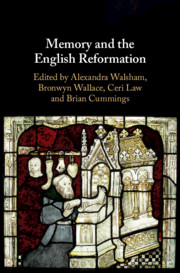Book contents
- Memory and the English Reformation
- Memory and the English Reformation
- Copyright page
- Dedication
- Contents
- Figures
- Contributors
- Preface and Acknowledgements
- Abbreviations
- Introduction
- Part I Events and Temporalities
- Part II Objects and Places
- 7 Dolls and Idols in the English Reformation
- 8 Monuments and the Reformation
- 9 Memorable Motifs
- 10 Revitalising Antiquities
- 11 Rereading Ruins
- 12 ‘Monuments of Our Indignation’
- Part III Lives and Afterlives
- Part IV Rituals and Bodies
- Index
12 - ‘Monuments of Our Indignation’
John Milton and the Reception of Reformation Iconoclasm in the Seventeenth Century
from Part II - Objects and Places
Published online by Cambridge University Press: 30 October 2020
- Memory and the English Reformation
- Memory and the English Reformation
- Copyright page
- Dedication
- Contents
- Figures
- Contributors
- Preface and Acknowledgements
- Abbreviations
- Introduction
- Part I Events and Temporalities
- Part II Objects and Places
- 7 Dolls and Idols in the English Reformation
- 8 Monuments and the Reformation
- 9 Memorable Motifs
- 10 Revitalising Antiquities
- 11 Rereading Ruins
- 12 ‘Monuments of Our Indignation’
- Part III Lives and Afterlives
- Part IV Rituals and Bodies
- Index
Summary
This chapter explores the reception of the visible legacy of sixteenth-century image-breaking in the years surrounding the English Civil War. For all its violence, the iconoclasm of the early Reformation never succeeded in banishing all superstitious images from English churches and cathedrals. In many places of worship, reminders of the old religion survived into the seventeenth century in the form of defaced carvings, headless statuettes, damaged picture windows and partially razed memorial brasses. Rightly or wrongly, seventeenth-century observers came to associate Reformation iconoclasm with a strategy of instructive defacement, intended to preserve visible examples of Catholic superstition marked with the imprint of reforming zeal. The Laudian reornamentation of English churches in the 1620s and 1630s led many puritans to conclude that the strategy of defacement had been a failure, and to call for a new wave of more thorough-going iconoclasm. Yet others, including John Milton, continued to embrace selective defacement as a model for coping with both literary and material idols.
- Type
- Chapter
- Information
- Memory and the English Reformation , pp. 238 - 254Publisher: Cambridge University PressPrint publication year: 2020

